TL; DR
Macroeconomic data shows that while inflation in the U.S. has shown signs of easing, it remains above the Federal Reserve's target. The labor market is overall robust, but consumer spending is slowing due to high interest rates. The Federal Reserve has kept interest rates unchanged and is cautious about rate cuts. Meanwhile, geopolitical conflicts in the Middle East have intensified market volatility. Although the resumption of trade talks between China and the U.S. provided a brief boost, the global economic outlook remains under pressure. Future market trends will be influenced by expectations of rate cuts and changes in international situations.
The cryptocurrency market is active overall, but momentum is weakening, with funds becoming cautious due to geopolitical risks. The market capitalization has decreased by 4.03%, with a clear return of funds to BTC, while ETH and stablecoins have shown stable performance. Newly launched tokens are mainly concentrated in the DeFi and Layer 1 sectors, with VC-backed projects still dominating, and market trends driven primarily by sentiment.
Despite geopolitical risks and the hawkish stance of the Federal Reserve putting pressure on market sentiment, both Bitcoin and Ethereum prices have retreated. However, Bitcoin spot ETFs have seen a net inflow of $1.13 billion, while Ethereum has experienced a net outflow of about $80 million due to a larger price drop, reflecting a rise in short-term risk-averse sentiment. Meanwhile, driven by stablecoin legislation and the positive impact of Circle's listing, the stablecoin market continues to expand, with an overall circulation increase of about $4.17 billion in June.
On June 22, after Trump announced a ceasefire between Israel and Iran, Bitcoin rebounded strongly, breaking through $108,000. Continuous net inflows into ETFs reflect bullish sentiment among institutions, and technical indicators show that bulls are regaining control, potentially challenging the historical high of $111,980 in the short term. Ethereum and Solana also rebounded simultaneously, and if they break through key moving average resistance, further upside potential may open up. Conversely, if they face resistance and decline, they may return to a consolidation pattern.
Circle's successful listing and the benefits from the passage of the "GENIUS Act" have strengthened the stablecoin sector, but its valuation is highly dependent on interest income, and its sustainability remains to be seen. Virtual has gained popularity in the Base ecosystem due to its innovative fundraising mechanism, with early users seeing significant profits. However, the "green lock mechanism" has restricted liquidity, leading to a decline in popularity, with token prices correcting over 30% from their highs.
The auction of Pumpfun's token, valued at $4 billion, has been postponed again, compounded by a trust crisis on the platform and ecological doubts, leading to market divergence on whether it can bring structural breakthroughs. Coinbase is advancing the integration of the Base chain with its main application, while JPMorgan is piloting the "deposit token" JPMD, marking a rapid layout of traditional institutions and centralized platforms in the on-chain dollar and compliant stablecoin sectors.
I. Macroeconomic Perspective
1. Inflation Trends
The CPI data for June 2025 shows that inflation growth has slowed to 3.3%, remaining flat month-on-month, with core CPI increasing by 3.4% year-on-year and 0.2% month-on-month. Although inflationary pressures have eased, the Federal Reserve still considers the current inflation level to be high, far from the 2% target. As more economic data accumulates, the Federal Reserve maintains a cautious stance, emphasizing the need for more positive data to support rate cut decisions.
2. Labor Market
The U.S. labor market remains relatively solid, with the unemployment rate slightly rising to 4.5%, just above the previous expectation of 4.4%. Despite the increase in the unemployment rate, it remains at a relatively low level, reflecting the stability of the labor market. Retail sales fell by 0.9% month-on-month, marking the largest decline in four months, particularly under high interest rates and potential inflationary pressures, which have significantly suppressed consumer spending, especially on durable goods and high-priced items.
3. Monetary Policy Dynamics
The Federal Reserve kept the federal funds rate unchanged at 4.25%-4.5% during the June meeting, marking the fourth consecutive time it has maintained rates. Although the Federal Reserve anticipates that it may cut rates twice before the end of 2025, it remains highly vigilant regarding inflation risks. The dot plot indicates expectations for rate cuts in the second quarter of 2025, but there is increasing divergence regarding the future monetary policy path, reflecting differing views within the Federal Reserve on the timing of rate cuts.
4. Trade Policy and Global Economic Outlook
In June, global markets were significantly affected by the escalation of geopolitical risks in the Middle East and the hawkish stance of the Federal Reserve, leading to a notable decline in market risk appetite. Israel's airstrikes on Iran triggered market panic, putting pressure on U.S. stock markets in the short term. Meanwhile, news of the resumption of trade negotiations between the U.S. and China in London briefly boosted market risk sentiment, but the escalation of geopolitical conflicts quickly disrupted market calm. As the global economic outlook remains under pressure, investors' risk appetite has generally declined.
5. Summary
June's macro data indicates that the U.S. economy still faces significant inflationary pressures. Although some inflation indicators have eased, overall economic growth expectations have been downgraded, and the Federal Reserve is cautious about rate cuts. Geopolitical conflicts in the Middle East have had a substantial impact on market sentiment, leading to increased volatility in the short term. However, as international situations stabilize and expectations for Federal Reserve rate cuts rise, market sentiment has improved. It is expected that in the coming months, the Federal Reserve may initiate a rate cut cycle supported by data, but it is also necessary to be wary of the ongoing impact of geopolitical uncertainties on the market.
II. Overview of the Cryptocurrency Market
Cryptocurrency Data Analysis
Trading Volume & Daily Growth Rate
According to CoinGecko data, as of June 25, the average daily trading volume in the cryptocurrency market was approximately $107.7 billion, a decline of 6.6% from the previous period. During this time, trading volume exhibited multiple "spike-and-drop" trends, with daily fluctuations generally exceeding 10%. On June 13, a peak trading volume of $167.9 billion was recorded, along with several instances of sharp corrections. Overall, while the market remains somewhat active, the momentum of funds has weakened compared to earlier periods, and due to geopolitical conflicts and other uncertainties, market funds have become cautious in late June, leading to a decline in risk appetite.
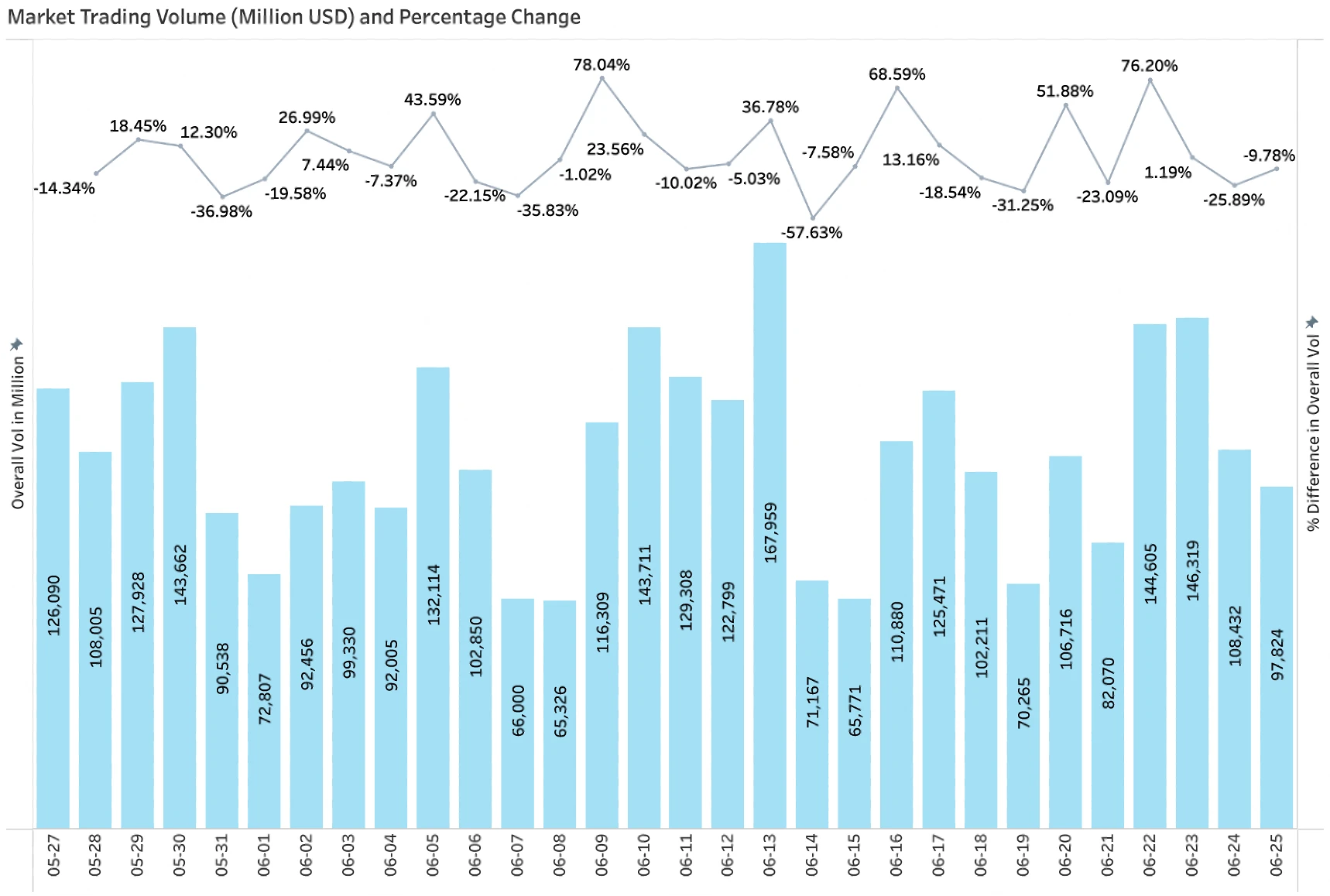
Total Market Capitalization & Daily Growth
According to CoinGecko data, as of June 25, the total market capitalization of cryptocurrencies has decreased to $3.40 trillion, down 4.03% from the previous month. BTC's market share has risen to 64.8%, while ETH's market share is at 9.0%, indicating a clear return of funds to BTC. Overall, BTC remains dominant, with ETH and stablecoins showing relatively stable performance, while short-term hot sectors are largely reliant on sentiment-driven speculation, lacking sustained support and struggling to form long-term incremental momentum.
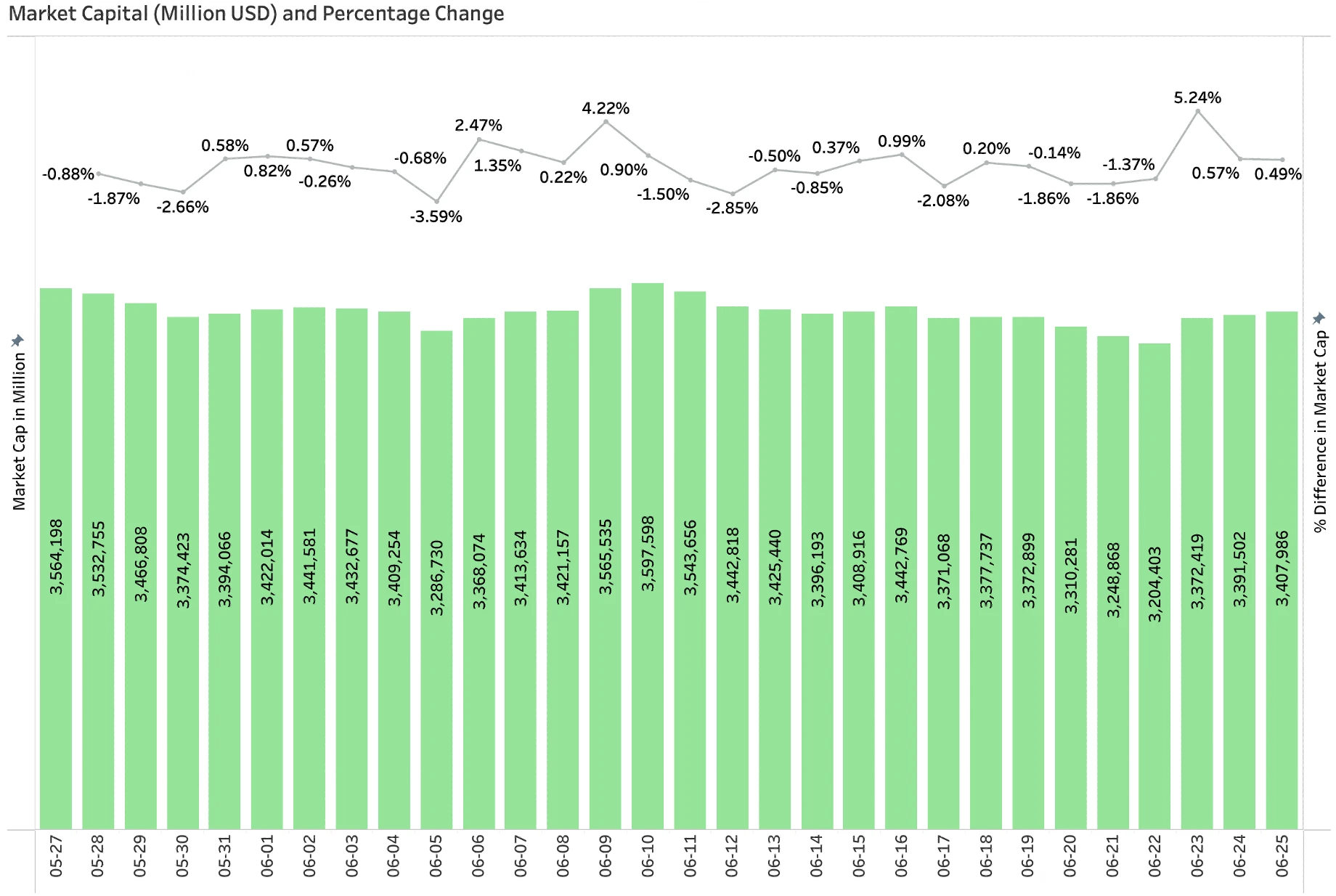
Newly Launched Popular Tokens in June
Among the popular tokens launched in June, those relying on Binance's Alpha listing route, with VC backing, continue to dominate. The hot sectors focus on DeFi and Layer 1, with DeFi projects such as SPK, RESOLV, and HOME gaining widespread market attention.
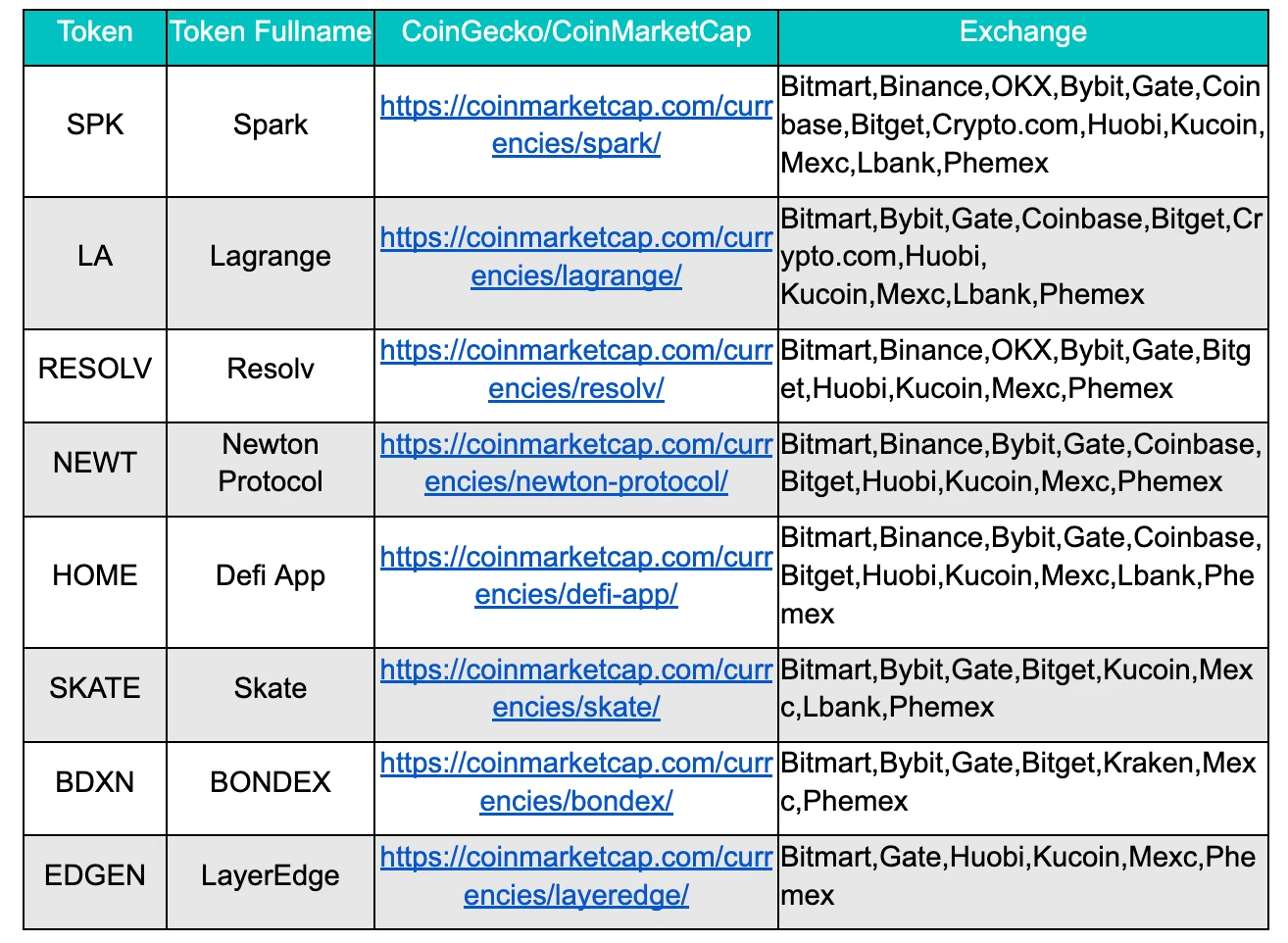
III. On-Chain Data Analysis
3.1 Analysis of BTC and ETH ETF Inflows and Outflows
June BTC ETF Inflow of $1.13 Billion
In June, the escalation of geopolitical risks in the Middle East and the Federal Reserve's hawkish stance led to a decline in market risk appetite, putting pressure on Bitcoin market sentiment and causing prices to trend downward. Bitcoin's price fell from $105,649 to $100,987, a decline of about 4.41%. Although a temporary ceasefire between Iran and Israel led to a price rebound, the market remains under the influence of war risks. Bitcoin spot ETFs have maintained a net inflow, reflecting traditional investors' confidence in long-term value, with a cumulative net inflow of approximately $1.13 billion in June.
June ETH ETF Outflow of $80 Million
For Ethereum, the impact of the war has led to a more significant price drop. ETH's price fell from $2,536 at the beginning of the month to $2,228, a decline of 12.1%. Correspondingly, Ethereum spot ETFs have seen net outflows, indicating a rise in short-term risk-averse sentiment, with a cumulative net outflow of about $80 million in June.
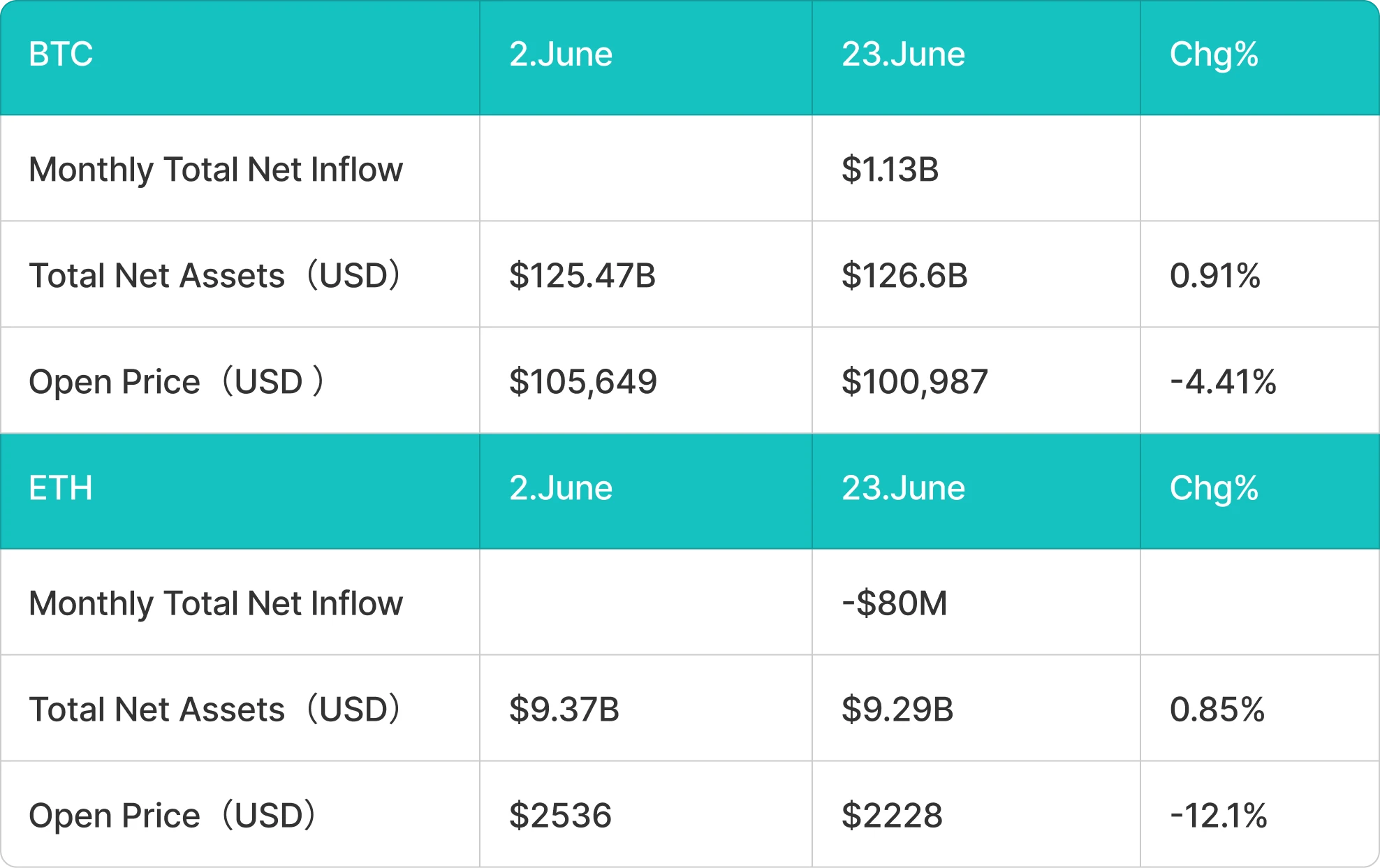
3.2 Analysis of Stablecoin Inflows and Outflows
June Stablecoin Inflow of Approximately $4.17 Billion—Mainly from USDT and USDC
In June, the stablecoin market continued its strong growth momentum, stimulated by favorable news regarding stablecoin legislation and Circle's listing on the U.S. stock market. Among them, USDT, USDE, and USDC have become the main drivers of growth this month, with the total circulation of stablecoins increasing by approximately $4.17 billion.
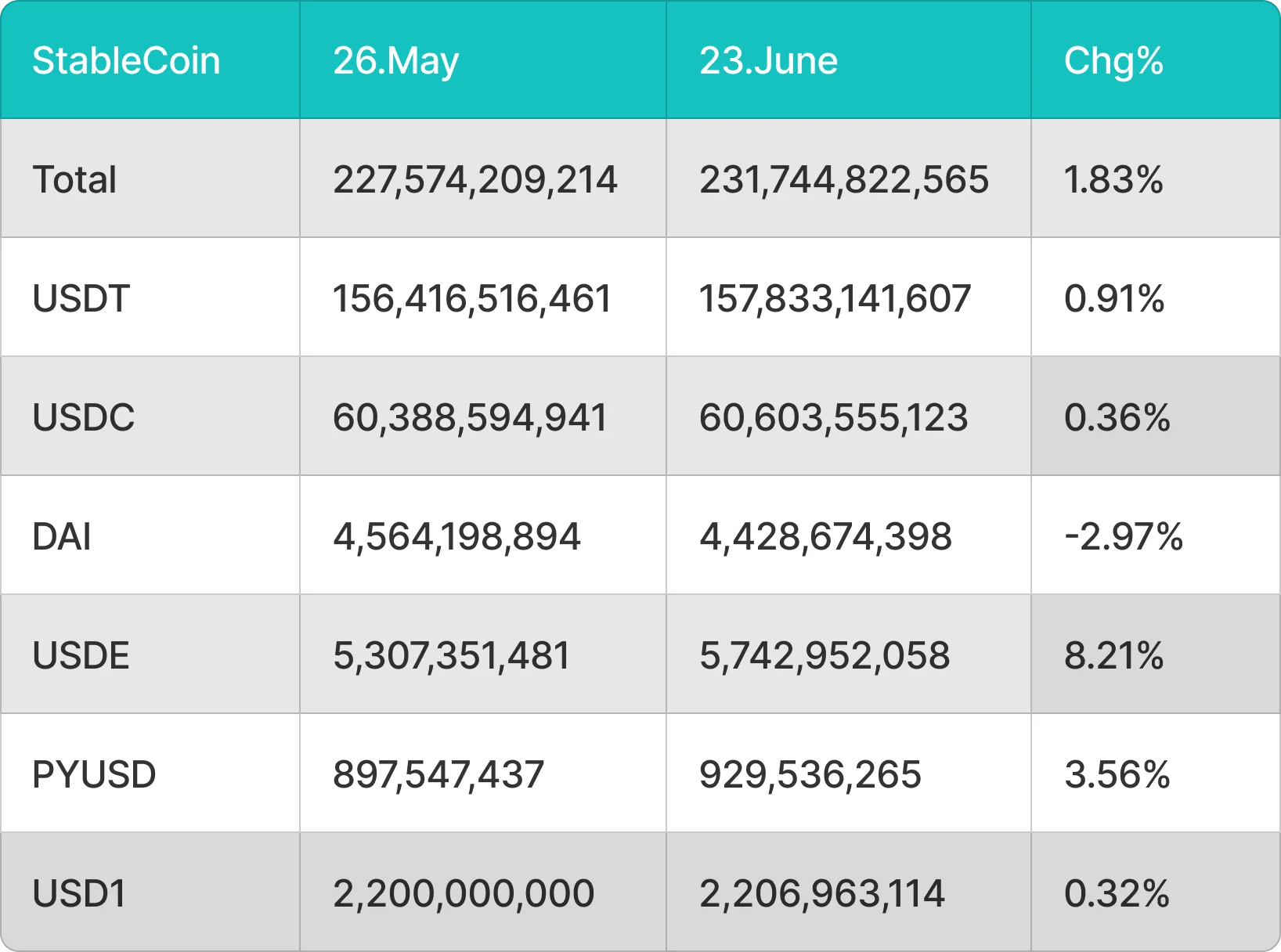
IV. Price Analysis of Mainstream Currencies
4.1 BTC Price Change Analysis
The rebound in Bitcoin that began on June 22 was triggered by U.S. President Donald Trump's announcement of a "full ceasefire" between Israel and Iran, with prices quickly breaking through $108,000, indicating strong bullish buying pressure. Despite recent geopolitical risks escalating, the U.S. spot Bitcoin ETF has recorded net inflows for 11 consecutive days, suggesting that institutional investor sentiment remains positive.
Currently, Bitcoin is poised to challenge the historical high of $111,980. However, without new catalysts, prices may continue to consolidate within a range.
On June 22, Bitcoin rebounded strongly from $100,000, breaking through major moving averages, indicating strong buying power at lower levels. The 20-day exponential moving average (EMA) has begun to rise, and the RSI indicator has also entered positive territory, both suggesting that bulls are regaining control of market momentum.
In the short term, bears may build a defense between the downtrend line and $111,980. If prices encounter resistance in that area but can find support near the 20-day EMA, it would indicate that bulls are buying on dips, and a further breakout attempt may follow. Conversely, if prices fall below the moving average support, BTC/USDT may continue to consolidate within the range of $98,200 to $111,980.
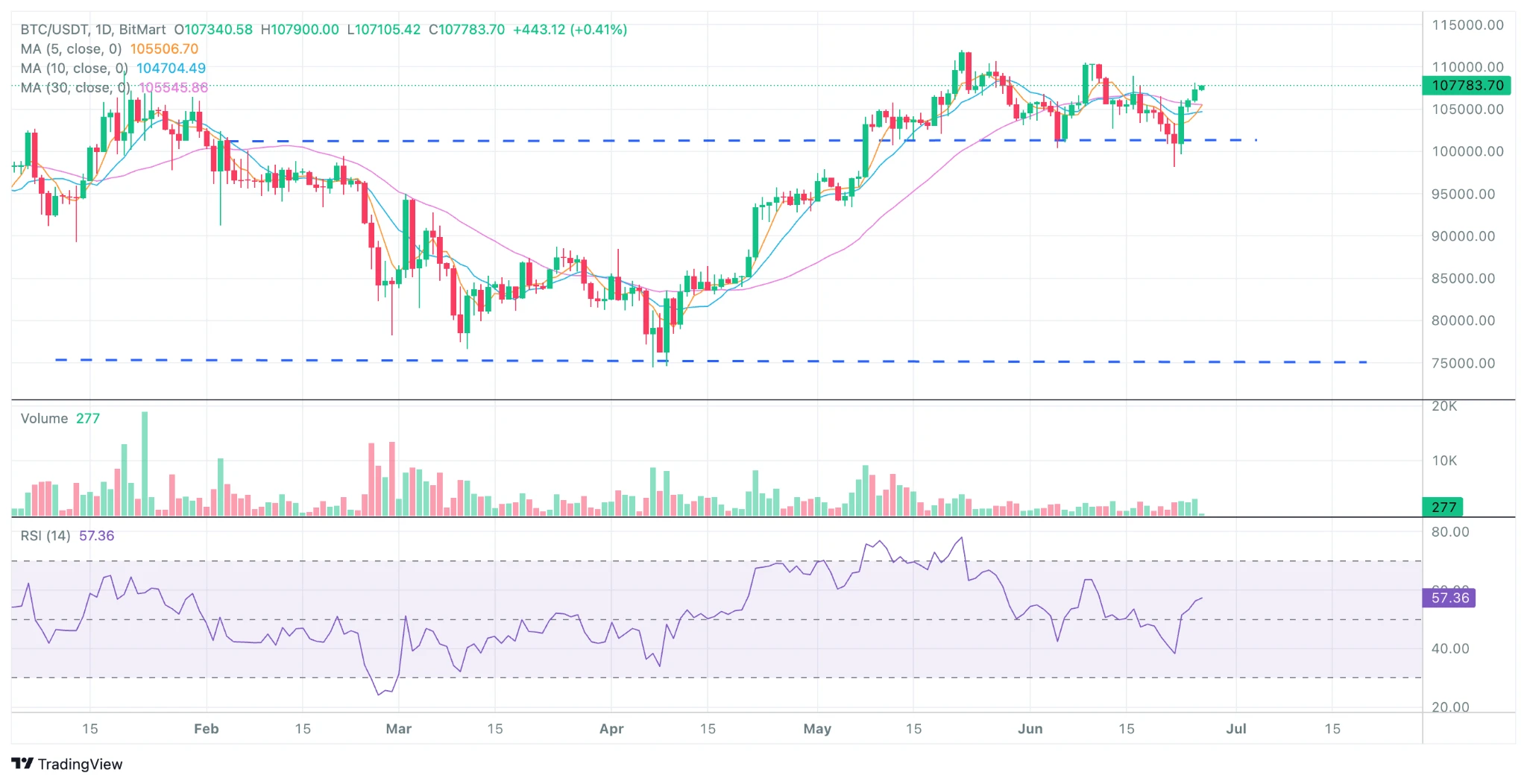
4.2 ETH Price Change Analysis
Ethereum rebounded from $2,111 on June 22 and reached the 20-day EMA ($2,473) on June 24. Currently, the 20-day EMA is flattening, and the RSI is approaching the midpoint, indicating that the market's bullish and bearish forces are temporarily balanced.
If the ETH price breaks through the various moving averages, it may open up upward space, targeting resistance levels of $2,738 and $2,879. Conversely, if the price is blocked near the 20-day EMA and falls below $2,323, it would indicate that bears are continuing to exert pressure during the rebound, and ETH/USDT may test the key support level of $2,111 again.

4.3 SOL Price Change Analysis
Solana rebounded from $126 on June 22 and broke through the key downward level of $140 on June 24. The current upward movement is encountering resistance near the 20-day EMA ($147), but a positive signal is that bulls have successfully defended the $140 level.
If the pullback is limited, the market may attempt to break through the 20-day EMA. Once stabilized, the SOL/USDT pair may further test the 50-day simple moving average (SMA) at the $160 level.
If bears successfully push the price back below $140, it could trigger further pullbacks, with support levels looking towards $123 and even $110.
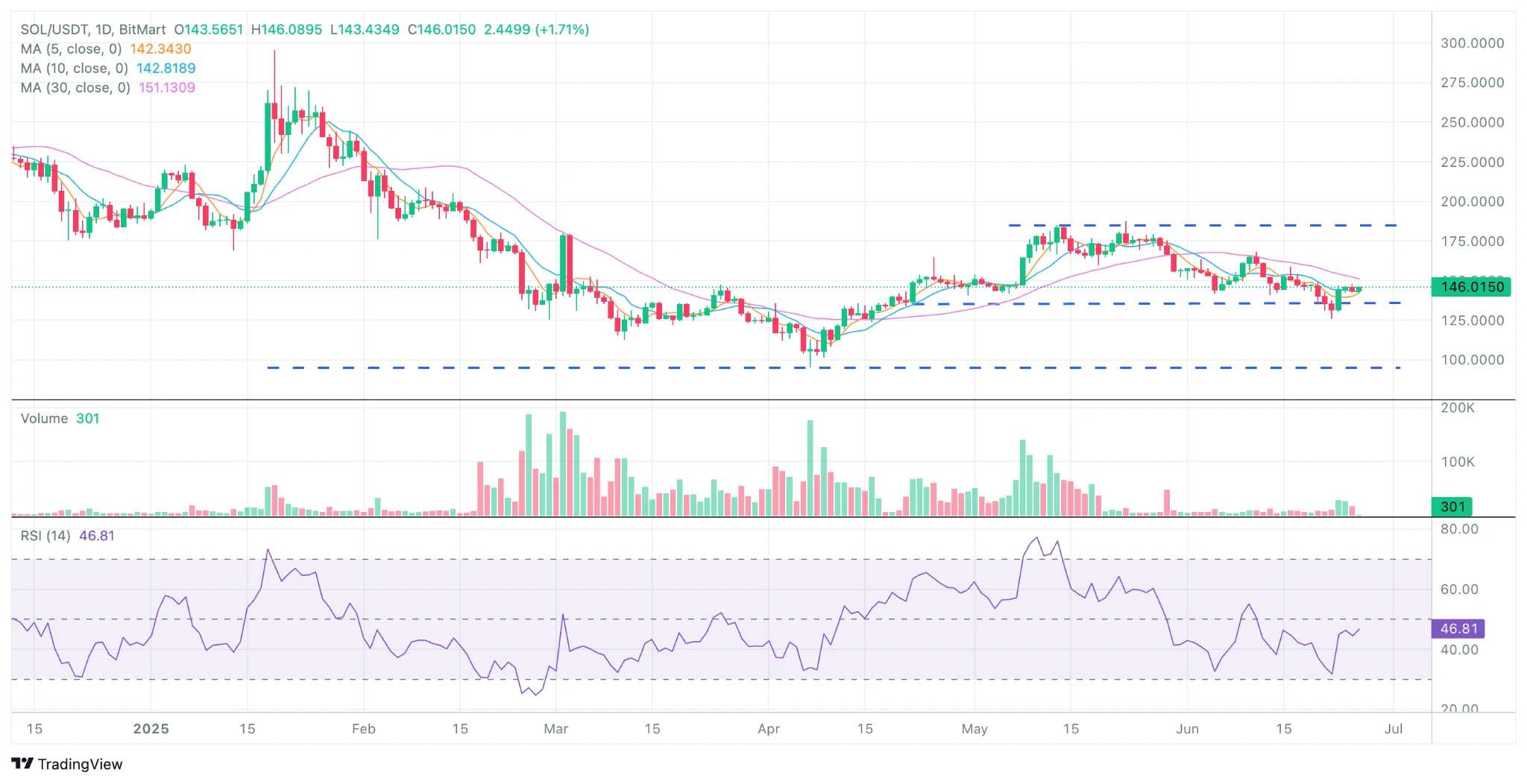
V. Hot Events This Month
1. Circle's Listing Sparks Stablecoin Craze
Circle's parent company, Circle Internet Group, successfully listed on the New York Stock Exchange on June 5, with its stock price soaring from an opening price of $31 to a peak of $298, an increase of 861%, giving it a market capitalization of approximately $76 billion. Subsequently, due to "Woodstock" Cathie Wood's ARK fund rapidly reducing its holdings by about 1.5 million shares post-IPO, cashing out over $330 million, the price fell to $198 by June 26, with a market cap of about $50.6 billion.
At its peak, Circle's market cap exceeded the actual circulating market cap of USDC, with its revenue primarily coming from USDC reserve interest, generating a total of $1.6 billion by the end of 2024, of which Coinbase received over half, becoming Circle's largest distribution cost source. Although the partnership is crucial for expanding USDC's ecosystem coverage, the current revenue structure also exposes Circle to the risk of over-reliance on interest income. If interest rates decline in the future, profitability will be squeezed. However, this IPO coincided with the U.S. Senate's passage of the "GENIUS Act," which strengthened policy support for compliant stablecoins and catalyzed market speculation on the "digital dollar" theme. Overall, Circle's listing marks an important milestone for the compliance of the stablecoin industry, with the market granting it a premium as the "leader of digital dollars." However, whether its long-term valuation can stabilize will still depend on its ability to break free from reliance on reserve income and build a sustainable, diversified revenue model.
2. Passage of the "GENIUS Act," Awaiting Presidential Signature
In June 2025, the U.S. Senate passed the "GENIUS Stablecoin Act" with an overwhelming majority (68-30), marking a historic step in U.S. cryptocurrency regulation. The act imposes strict compliance requirements on stablecoin issuers, including 1:1 dollar or short-term U.S. Treasury reserves, monthly audits, a ban on interest-bearing stablecoins, and allowing only bank subsidiaries or federally or state-authorized entities to issue stablecoins. The act explicitly brings stablecoins under the regulatory scope of the Bank Secrecy Act, establishing their legal status as "digital currency," and is seen as an important milestone in promoting the mainstream adoption of digital assets. Domestic platforms like Circle and Coinbase are direct beneficiaries, with Circle's market cap soaring by 35% after the act's passage, while Tether faces multiple compliance challenges regarding audit qualifications and reserve structures.
Although the act still awaits a vote in the House of Representatives and presidential signature, Trump has publicly endorsed it on social media, calling it the "foundational project for the digital dollar." Overall, the passage of the "GENIUS Act" is both a strategic move for the U.S. to compete for dominance in digital currency and may become a benchmark for global stablecoin regulation, with the stablecoin market poised for explosive growth as the U.S. financial system accelerates towards a more digital and globalized era.
3. Virtual: Pumpfun + Bn Alpha New Mechanism Ignites Market Interest
This month, Virtual has undoubtedly been one of the most closely watched projects in the market. With its innovative fundraising mechanism, it quickly attracted a large amount of capital and user participation, becoming the core representative of the current Base ecosystem's fundraising narrative. The price of VIRTUAL surged from $0.50 in mid-April to a peak of $2.50 in early June, an increase of 400%. The core advantages of Virtual's fundraising include:
Extremely low financing price: Each new project raises funds with a market cap of 42,425 virtual tokens (approximately $224,000), allowing users to participate in financing at a very low price, with significant potential profit space after the project launches.
Token linear unlocking: Unlike MEME on PumpFun, Virtual's fundraising projects do not unlock all tokens at launch but have a transparent token economic model with phased unlocking, similar to VC tokens. Additionally, to prevent project teams from dumping tokens, the raised funds are not directly handed over to the project team but are all injected into the initial liquidity pool.
Low fundraising risk: If a project fails to raise funds, users will receive a full refund, and Virtual only launches a few new projects each day, ensuring that the quality is generally higher than MEME, resulting in low risk for user participation.
Reduced rug pull probability for project teams: Virtual sets a 1% fee, with 70% returned to the project team. This incentive model motivates project teams to enhance trading activity rather than cashing out in the short term, creating a positive ecological loop.
However, as the platform's popularity rises, early users frequently sell immediately after the fundraising launch to gain short-term high returns, creating significant selling pressure on new projects and undermining the overall stability of the ecosystem. To address this, Virtual introduced a "green lock mechanism" in mid-June, imposing a mandatory lock-up period for fundraising users during which they cannot sell the tokens obtained. Violators will have their points accumulation suspended. While this mechanism helps curb early selling and extend project lifecycles, it also significantly alters the original speculative logic. Users' profit cycles are forced to lengthen, capital efficiency declines, and market enthusiasm has shown signs of a temporary retreat. The price of Virtual entered a downward channel in mid-June, falling from its peak to $1.69, a decline of over 37%.
VI. Outlook for Next Month
1. Pumpfun: $4 Billion Valuation Token Auction Postponed Again
The Pumpfun token auction originally scheduled for the end of June has been postponed again, now expected to take place in mid-July. This marks multiple delays since the initial proposal for token issuance last year. It is reported that Pumpfun plans to raise $1 billion at a valuation of $4 billion (FDV) and intends to airdrop 10% of tokens for community incentives.
Since its launch, Pumpfun has achieved approximately $700 million in revenue through low fees and a binding curve mechanism, becoming one of the most profitable projects on the Solana chain. However, its ecosystem is facing multiple trust challenges, including rampant bot trading, stagnation in product innovation, and unclear use of funds. In mid-June, the platform and founder's social media accounts were banned on X, further fueling the spread of false news about "regulatory intervention" and "founder arrest," amplifying market concerns. Whether this high-valuation financing can bring structural breakthroughs to the Solana ecosystem or become another capital harvest remains a point of contention in the market.
2. Coinbase Advances Integration of Base Chain, JPMorgan Trials "Deposit Token"
Coinbase is currently promoting the deep integration of the Base chain into its main application, having launched the Coinbase Verified Pools feature, allowing KYC users to directly use their Coinbase account balance to interact with DApps on Base without cumbersome wallet switching and on-chain transfer processes. Uniswap and Aerodrome have been announced as its DEX platforms for on-chain trading. Although this feature is still in its early stages, it aligns closely with the current trend of several centralized trading platforms pushing for on-chain and off-chain integration. For example, Binance allows exchange users to directly purchase on-chain tokens through its Alpha system, while Bybit has launched Byreal to provide its exchange users with DeFi functionalities for trading popular on-chain tokens and Solana assets. The one-stop trading experience between centralized exchanges and on-chain trading has become an important direction for platform evolution.
Meanwhile, JPMorgan is piloting the "deposit token" JPMD on the Base chain as a compliant digital dollar tool for institutions, supported by bank deposits and limited to licensed use. From an industry perspective, the combination of Coinbase and Base strengthens its compliance chain positioning and entry-level advantages. If application-level integration is achieved in the future, it could significantly expand the active user base on-chain. JPMorgan's pilot reflects the positive impact of the passage of the "GENIUS Stablecoin Act," as traditional institutions begin to heavily invest in the on-chain dollar sector. In the context of gradually loosening policies, this may inject new variables into the competitive landscape for compliant stablecoins. Both can be seen as important signals under the trend of "centralized institutions and on-chain ecosystems," warranting close attention to their subsequent scaling and policy interaction effects.
免责声明:本文章仅代表作者个人观点,不代表本平台的立场和观点。本文章仅供信息分享,不构成对任何人的任何投资建议。用户与作者之间的任何争议,与本平台无关。如网页中刊载的文章或图片涉及侵权,请提供相关的权利证明和身份证明发送邮件到support@aicoin.com,本平台相关工作人员将会进行核查。




